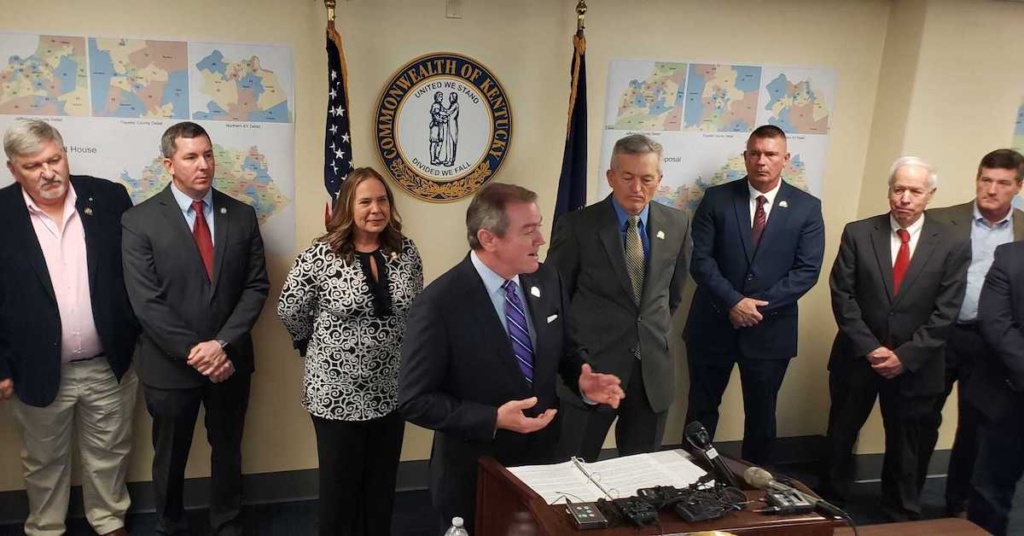Republican leaders of the Kentucky House of Representatives have unveiled what legislative districts will likely look like over the next decade.
The proposed map would significantly redraw the House’s political boundaries across the state. Four pairs of incumbent lawmakers would be put into the same districts, meaning they would have to run against each other during the 2022 elections.

The affected lawmakers and districts are:
- Democratic Reps. Mary Lou Marzian and Josie Raymond, who currently represent Louisville House districts 34 and 31, respectively.
- Democratic Reps. McKenzie Cantrell and Lisa Willner, who currently represent Louisville House districts 38 and 35, respectively.
- Republican Reps. Norma Kirk-McCormick and Bobby McCool, who currently represent eastern Kentucky House districts 93 and 97, respectively.
- Republican Reps. Lynn Bechler and Jim Gooch, who currently represent western Kentucky House districts 4 and 12, respectively.
House Speaker David Osborne said the consolidation of districts was due to shifts in population and keeping “communities as intact as possible.”
“I think where we had population loss in far eastern Kentucky, far western Kentucky and trying to fit those pieces back together in consideration of that population loss was very difficult and results in a lot of change,” Osborne said.
You can find out which state House and Senate district you currently live in on the legislature’s website.
Republicans currently control 75 of the 100 seats in the House, a high-water mark for the party. Democrats have 24 seats and one district is vacant following the retirement of longtime Rep. Reginald Meeks.
Osborne said the House’s proposed map also creates four “majority-minority” districts—ones that are mostly comprised of racial minorities. Currently, two of the 100 House seats are majority-minority districts. The two new ones are House District 40, currently represented by Nima Kulkarni, and House District 44, held by Joni Jenkins, both Democrats from Louisville.
Jenkins, House Democratic leader, called the release of the redistricting plan “an attempt at fake transparency.”
“I would hope we could get to a place where we could do this in a way that the community has some input, that it’s not done behind closed doors,” Jenkins said. “If you’re going to drop something like this, at least drop it in its entirety so people can at least get the information they need.”
As of Thursday, the House GOP redistricting plan included only a broad look at what districts will look like. Precinct-level data still hasn’t been published.
The state legislature has to draw new boundaries for legislative and congressional districts every 10 years to account for shifts in population.
Though Kentucky’s population increased by about 150,000 over the last decade, within the state, people moved from rural regions of the state, especially in far eastern and western Kentucky, to more urban and suburban areas.
This is the first time Republicans are totally in charge of the process in Kentucky, after the statehouse was at least partly controlled by Democrats until 2017.
GOP leaders of the legislature have been drawing the maps behind closed doors and Thursday’s announcement is the first time the public has gotten a look at what they look like.
Osborne dismissed concerns that the process was being rushed and challenged critics to draw their own versions of the map.
“It boils down to math and sheer numbers, and I think while somebody might not like the idea of two counties being put together, the fact of the matter when you look at those two counties and every county surrounding it as it relates to the context of the entire state, there may not be any other option,” Osborne said.
The Senate hasn’t unveiled its map yet, and Osborne said Senate leaders are drawing the state’s six Congressional districts.
Lawmakers will try to pass the maps quickly during the upcoming legislative session, which begins on Jan. 4. Osborne said lawmakers will try to pass the plan out of both chambers of the legislature by Saturday, Jan. 8 — a five-day span, the fastest possible timeline.
The process also includes a plan to delay the filing deadline for candidates running for office in Kentucky. Currently, the deadline is Jan. 7. But because candidates won’t know what their districts will look like at that point, lawmakers plan to delay the deadline to Jan. 25.
Democratic Gov. Andy Beshear will have an opportunity to veto the redistricting plan, but the legislature can easily override him with a majority of votes in each chamber.






